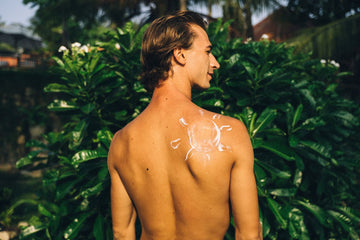When people shop for sunscreen, one of the first questions is: what’s the difference between SPF 30 and 50? At first glance, those numbers seem confusing. You might think SPF 50 is almost double the strength of SPF 30 but that’s not exactly how it works. Both options give you strong protection, but the right choice depends on your skin, how much time you spend outside, and your lifestyle.
If you’re choosing between SPF 50 sunscreen vs SPF 30, understanding how SPF works makes it easier to pick what actually keeps you safe (and comfortable) under the sun.
What SPF Really Means
SPF stands for Sun Protection Factor, and it tells you how well a sunscreen blocks UVB rays the ones that cause sunburn. Think of SPF like a filter.
- SPF 30 lets about 3% of UVB rays through, blocking 97%.
- SPF 50 lets about 2% of UVB rays through, blocking 98%.
That’s only a 1% difference, but if your skin is sensitive or you’re under harsh sunlight for hours, that little margin can make a difference. Still, remember SPF only covers UVB.
For full protection, always look for broad-spectrum sunscreen so you’re also shielded against UVA rays (the ones linked to ageing and long-term damage).
SPF 30 vs SPF 50: Side-by-Side
| Feature | SPF 30 | SPF 50 |
|---|---|---|
| UVB protection | ~97% | ~98% |
| Rays reaching skin | 3% | 2% |
| Good for | Everyday indoor-outdoor use, errands, office commutes | Long hours outdoors, beach days, sports, sensitive skin |
| Reapplication | Every 2 hours (more if swimming/sweating) | Every 2 hours (still required) |
| Feel | Usually lighter formulas | Often thicker or water-resistant |
A quick analogy: SPF 30 is like locking your front door it keeps most trouble out. SPF 50 is like locking the door and also adding a security chain. It’s not a total guarantee, but it’s a stronger backup.
When SPF 30 Is Enough
For many people, SPF 30 sunscreen is perfectly fine for daily use. It works well if:
- You’re mostly indoors and only step out briefly.
- Your sun exposure is light like commuting, errands, or a short walk.
- You want a lightweight SPF body sunscreen that doesn’t feel heavy.
- It’s cloudy or the UV index is low (though sunscreen is still a must).
As long as you apply enough, pick a broad-spectrum formula, and reapply, SPF 30 offers reliable everyday protection.
When SPF 50 Makes More Sense
SPF 50 sunscreen is better if:
- You have fair or sensitive skin that burns quickly.
- You’ll spend hours outside beach, hiking, sports.
- You live somewhere with intense sunlight or high UV.
- You tend to forget reapplying and want a little buffer.
Even though SPF 50 is only slightly stronger than SPF 30, that extra margin can give peace of mind in harsher conditions.
See Vixxar
Mineral Sunscreen SPF30 – Face & Body Protection Without White Cast (150ml)
SPF 50 Sunscreen Stick Mineral Tinted
See more off Vixxar's all natural Sunscreen Products.
SPF for Face vs SPF for Body
Not all sunscreens are created equal for face and body.
-
SPF for Face: Look for formulas made for facial skin—lightweight, non-greasy, and often with extra skincare benefits. Many people use SPF 30 daily on the face, and SPF 50 if they’ll be outside for longer.
-
SPF for Body: Body sunscreens often come in larger bottles, feel creamier, and are easier to spread. SPF 30 works for day-to-day, but SPF 50 body sunscreen is great for outdoor activities, water sports, or long exposure.
Tip: Don’t mix them up. Facial skin is more sensitive, so body sunscreen can clog pores, while face sunscreen might not spread as easily on larger areas.
Common Myths About SPF
-
“SPF 50 lasts twice as long as SPF 30.”
Wrong. Both need reapplication every two hours (or sooner if swimming/sweating). -
“SPF 30 is too weak.”
Not true. SPF 30 blocks 97% of UVB rays, which is plenty for daily life. -
“If I wear SPF 50, I don’t need hats or shade.”
Also false. Sunscreen helps, but shade, clothing, and sunglasses matter too. -
“Higher SPF means 100% protection.”
No sunscreen blocks everything. Even SPF 50 lets a small amount of rays through.
Tips to Get the Most Out of Sunscreen
-
Use enough about 2 tablespoons for your whole body.
-
Apply 15–30 minutes before going out.
-
Reapply every 2 hours.
-
Cover all exposed spots (don’t forget ears, neck, and feet).
-
Choose broad-spectrum, water-resistant formulas.
-
Find a sunscreen you like wearing you’ll actually use it.
SPF for the Face
Facial skin is thinner and often more sensitive. Many people prefer SPF 30 face creams because they’re lightweight, less greasy, and easier to wear under makeup. If you spend a lot of time outside or have sensitive skin, though, an SPF 50 face sunscreen gives added peace of mind.
SPF for the Body
For your arms, legs, and shoulders, a SPF body sunscreen is usually thicker and water-resistant. SPF 30 is great for regular errands or light outdoor activity, but if you’re planning a full day at the beach, SPF 50 sunscreen is a better bet especially since body application is often uneven.
Conclusion
The real difference in SPF 50 sunscreen vs SPF 30 isn’t just about numbers it’s about how you use it. SPF 30 works great for daily routines, while SPF 50 is smarter for extended outdoor exposure or if you have sensitive skin.
The key is consistency. The sunscreen you enjoy putting on whether SPF 30 or 50 is the one that will actually protect you.
FAQs
Q: Is SPF 50 better than SPF 30 for the face?
Slightly, yes. SPF 50 gives more coverage, but SPF 30 is enough for most people if applied properly. For sensitive skin, go with SPF 50.
Q: Which is better: 30 spf vs 50 spf?
Depends on your situation. Indoors + short trips = SPF 30. Long outdoor days = SPF 50.
Q: Is SPF 30 enough for body sunscreen?
Yes, for normal daily activities. If you’re outside all day, SPF 50 body sunscreen is a safer bet.
Q: What SPF is recommended for the face?
Dermatologists usually suggest SPF 30 or higher every day, and SPF 50 if you’ll be under strong sun for hours.






